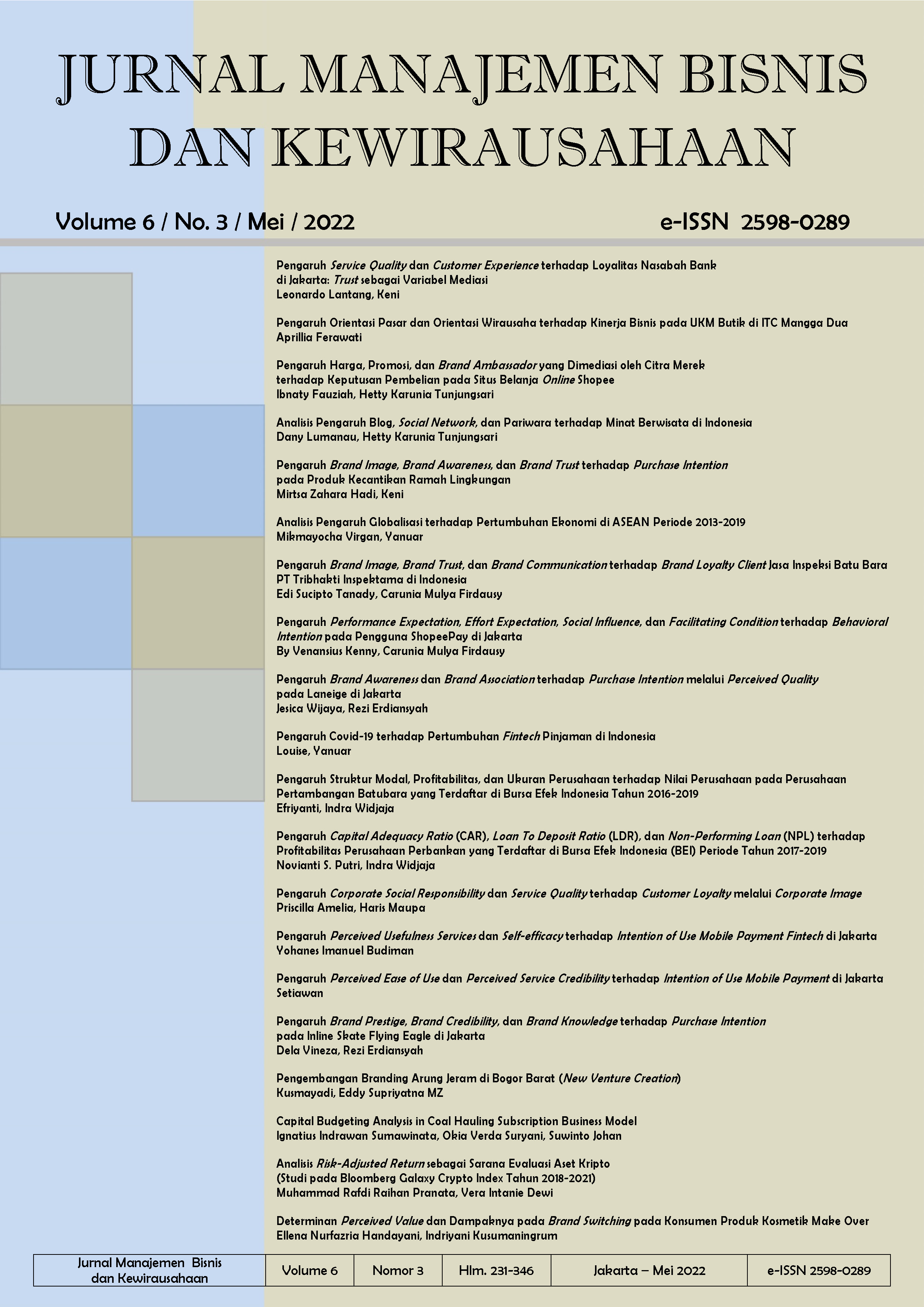Pengaruh Brand Image, Brand Trust, dan Brand Communication terhadap Brand Loyalty Client Jasa Inspeksi Batu Bara PT Tribhakti Inspektama di Indonesia
Main Article Content
Abstract
The objective of this study is to examine the influences of brand image, brand trust, and brand communication on the brand loyalty of PT Tribhakti Inspektama clients in Indonesia. The number of respondents sampled was 115 respondents. These respondents were sampled by using the nonprobability sampling technique. The instruments to collect the data were collected by using an online questionnaire. The Method to analyze the data was by using multiple regression analysis. The results showed that brand image, brand trust, and brand communication have positive and significant influences on the brand loyalty of the clients of PT Tribhakti Inspektama. Therefore, PT Tribhakti Inspektama needs to give particular attention to brand image, brand trust, and brand communication to create brand loyalty for the clients. This is important to improve the company’s strength to get repeat orders and reduce the company’s burden to find new clients.
Penelitian ini bertujuan untuk menguji pengaruh citra merek, kepercayaan merek, dan komunikasi merek terhadap loyalitas merek client PT Tribhakti Inspektama di Indonesia. Jumlah responden yang dijadikan sampel adalah 115 responden. Responden ini diambil sampelnya dengan menggunakan teknik nonprobability sampling. Instrumen untuk mengumpulkan data dikumpulkan dengan menggunakan kuesioner online. Metode analisis data menggunakan analisis regresi berganda. Hasil penelitian menunjukkan bahwa citra merek, kepercayaan merek, dan komunikasi merek berpengaruh positif dan signifikan terhadap loyalitas merek client PT Tribhakti Inspektama. Oleh karena itu, PT Tribhakti Inspektama perlu memberikan perhatian khusus pada citra merek, kepercayaan merek, dan komunikasi merek untuk menciptakan loyalitas merek dari client. Hal ini penting untuk meningkatkan kekuatan perusahaan untuk mendapatkan repeat order dan mengurangi beban perusahaan untuk mencari client baru.
Article Details
This work is licensed under a Jurnal Manajemen Bisnis dan Kewirausahaan Creative Commons Attribution-ShareAlike 4.0 International License.
References
Abdullah, A. (2015). A structural model of the relationships between brand image, brand trust and brand loyalty. International Journal of Management Research & Review, 5(3), 137–145. https://www.researchgate.net/profile/Abdullah-Alhaddad/publication/277299980_A_STRUCTURAL_MODEL_OF_THE_RELATIONSHIPS_BETWEEN_BRAND_IMAGE_BRAND_TRUST_AND_BRAND_LOYALTY/links/5565e97308aefcb861d1929e/A-STRUCTURAL-MODEL-OF-THE-RELATIONSHIPS-BETWEEN-BRAND-IMA
Algesheimer, R., Dholakia, U. M., & Herrmann, A. (2005). The social influence of brand community: Evidence from European car clubs. Journal of Marketing, 69(3), 19–34. https://doi.org/10.1509/jmkg.69.3.19.66363
Carroll, B. A., & Ahuvia, A. C. (2006). Some antecedents and outcomes of brand love. Marketing Letters, 17(2), 79–89. https://doi.org/10.1007/s11002-006-4219-2
Cassia, F., Cobelli, N., & Ugolini, M. (2017). The effects of goods-related and service-related B2B brand images on customer loyalty. Journal of Business and Industrial Marketing, 32(5), 722–732. https://doi.org/10.1108/JBIM-05-2016-0095
Chaudhuri, A., & Holbrook, M. B. (2001). The chain of effects from brand trust and brand affect to brand performance: The role of brand loyalty. Journal of Marketing, 65(2), 81–93. https://doi.org/10.1509/jmkg.65.2.81.18255
Chen, C. F., & Chang, Y. Y. (2008). Airline brand equity, brand preference, and purchase intentions-The moderating effects of switching costs. Journal of Air Transport Management, 14(1), 40–42. https://doi.org/10.1016/j.jairtraman.2007.11.003
Chinomona, R. (2016). Brand communication, brand image and brand trust as antecedents of brand loyalty in Gauteng Province of South Africa. African Journal of Economic and Management Studies, 7(1), 124–139. https://doi.org/10.1108/AJEMS-03-2013-0031
Clow, K. E., & Baack, D. (2018). Integrated advertising, promotion, and marketing communications. Pearson Education.
Gefen, D., Karahanna, E., & Straub, D. W. (2003). Trust and TAM in online shopping: An integrated model. MIS Quarterly: Management Information Systems, 27(1), 51–90. https://doi.org/10.2307/30036519
Keller, K. L., & Lehmann, D. R. (2006). Brands and branding: Research findings and future priorities. Marketing Science, 25(6), 740–759. https://doi.org/10.1287/mksc.1050.0153
Kotler, P., & Keller, K. L. (2016). Marketing management (15th ed.). Pearson Education.
Mudambi, S. M., Doyle, P., & Wong, V. (1997). An exploration of branding in industrial markets. Industrial Marketing Management, 26(5), 433–446. https://doi.org/10.1016/S0019-8501(96)00151-4
Pavlou, P. A., Huigang, L., & Yajiong, X. (2007). Understanding and mitigating uncertainty in online exchange relationships: A principal-agent perspective. MIS Quarterly: Management Information Systems, 31(1), 105–135. https://doi.org/10.2307/25148783
?ahin, A., Zehir, C., & Kitapçi, H. (2011). The effects of brand experiences, trust and satisfaction on building brand loyalty; An empirical research on global brands. Procedia - Social and Behavioral Sciences, 24(1197), 1288–1301. https://doi.org/10.1016/j.sbspro.2011.09.143
Schiffman, L. G., & Kanuk, L. (2014). Consumer behavior (11th ed.). Pearson Education.
Shankar, V., Smith, A. K., & Rangaswamy, A. (2003). Customer satisfaction and loyalty in online and offline environments. International Journal of Research in Marketing, 20(2), 153–175. https://doi.org/10.1016/S0167-8116(03)00016-8
Wang, Y. D., & Emurian, H. H. (2005). An overview of online trust: Concepts, elements, and implications. Computers in Human Behavior, 21(1), 105–125. https://doi.org/10.1016/j.chb.2003.11.008
Zehir, C., ?ahin, A., Kitapçi, H., & Özçahin, M. (2011). The effects of brand communication and service quality in building brand loyalty through brand trust; the empirical research on global brands. Procedia - Social and Behavioral Sciences, 24, 1218–1231. https://doi.org/10.1016/j.sbspro.2011.09.142


